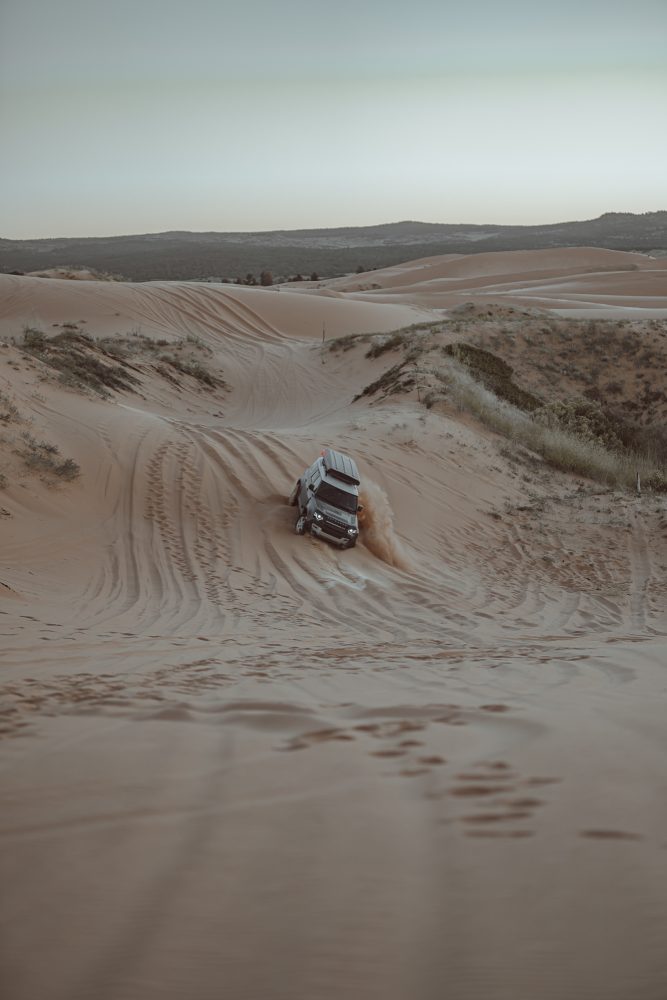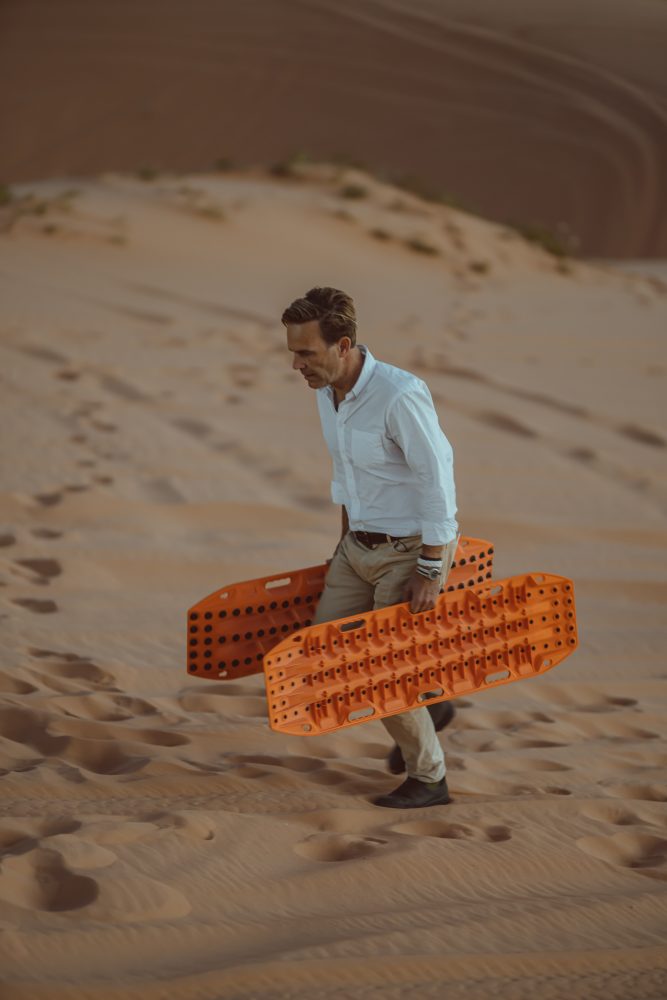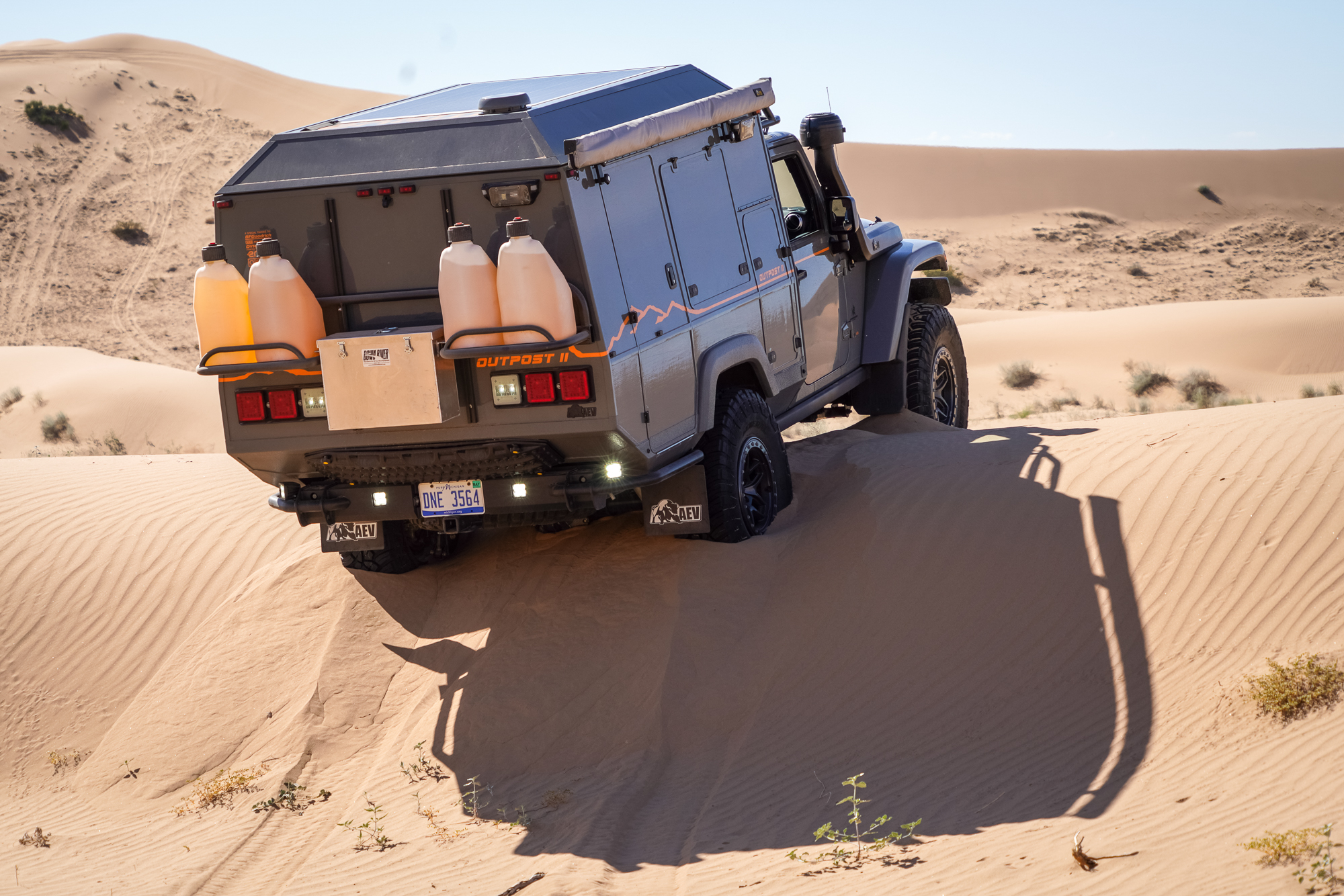Editor’s Note: This article was originally published in Overland Journal’s Gear 2022 Issue.
It’s 125°F with a sticky 90 percent humidity level in the Al Badayer Desert, and I am seriously stuck. The Range Rover has four dangling wheels from when I’d gotten a little too excited with the throttle. I try to open the driver’s door, but it’s got me locked in with 10 inches of sand up the sides. I’ve been in-country for four days, and this is my first day solo in the desert.
I’m here doing some testing and providing feedback to the engineering team at Land Rover. They’ve hired me to come over to their Middle East test center for half a year to explore their fleet’s capability in real-life conditions. My typical work week consists of five 10- to 12-hour days, driving prototype and pre-production vehicles. I thought I was already an expert sand driver coming in, but I quickly discerned I was wrong. Driving the dune complexes we have in the States barely translates to the scope, size, and ultimate isolation of those in the Middle East. Hopefully, some of the lessons cultivated from my experiences will benefit you as well.

Avoid trying to make any driving rules when it comes to sand. Anyone who tells you that they don’t get stuck in dunes is likely not telling the truth. The better you become as a driver, the more you can recognize areas where you’ll probably get stuck; you’ll make quicker choices behind the wheel, but you will get stuck nonetheless. Plan on it.
The elements in the desert can be brutal. Sunburn, dehydration, and exhaustion happen quickly. Most of us know we need water and to wear a hat, but it goes far beyond that. Nothing bothers me more than seeing someone get stuck and then hop out in flip-flops with a black T-shirt and a baseball hat. Of course, they usually have every item under the sun bolted or strapped onto their overweight and underpowered super overlanding rig. If you can’t equip your own person, don’t bother with the vehicle. My desert clothing consists of lightweight hiking boots with a good pedal feel, thin wool socks, lightweight nylon or cotton pants, an undershirt, and a nylon travel shirt with long sleeves that I can roll up. A shemagh or sun hat works great as well. Make sure to have a fleece jacket in the car (cold desert nights), and leather well-fitting work gloves are a must.
Basic Recovery Gear
Let’s move on to what we need in the vehicle. Make sure to purchase high-quality items; I cannot stress this point enough. Basic needs for recovery in the desert include the following:
- Set of sand ladders
- Tire deflation system (or gauge at a minimum)
- Electric tire pump designed for a high-duty cycle
- Flat-bladed, short-handled shovel
- Two properly rated bow shackles
- Non-stretch recovery strap, 10-foot
- Low stretch recovery strap, 30-foot
I’m standing alone in the desert, with my Range Rover buried in the sand. There are no support vehicles and no trees—only the sand, heat, and gear in the trunk. I shut the engine off because the heat coming from under the vehicle is excruciating, then grab the shovel and start digging. I begin in the front, pulling sand from under the front end blade by blade. After 20 minutes of digging, my heart rate had risen to 155 beats per minute; I had only removed 10 percent of what needed to come out. I change my strategy and dig around the outside of the bellied beast, thinking maybe I can rock it out. An hour later, I am finally in a position to give it another try. Out comes my pair of MaxTrax, wedged under the front tires. Pushing the start button, I recognize the long crank as the vehicle works out how to turn over with the heat-soaked fuel lines. I put the vehicle in first gear and ease on the throttle. I hear the MaxTrax under the tire tread grasping for traction, and then I feel some movement. Implementing a tad more throttle, I hear a loud “thump” followed by the wheels spinning and the vehicle digging downward again. I am stuck again.
The Importance of Tire Pressure
We learn early on that tire pressure is vital to sand driving, and this is definitely true. For me and the work I was doing, I had to precisely load the vehicle to full GVW and run full tire pressure to verify operation and make sure everything was working as designed. Of course, I could deviate from that plan if I needed to, but that would mean a retest which would put me one more day behind in the test schedule. Here are a couple of pieces of advice on airing down:
- Only air down the tires to what you need or suspect you need.
- Understand that flat tires do happen in the sand, and your vehicle reacts differently with soft tires, which means you need a full-size spare and a means to change the tire.
- Use at least an 18- x 18-inch piece of 3/4-inch plywood to act as a jacking board. Ideally, you’ll need a jack that gets under the frame rail. Another option in a pinch is to high center the vehicle and dig under the wheel to change it.
- Start at 20 psi; drive a bit, and see how it’s working. If you need softer, go down to your rim diameter. If you’ve got 16-inch rims, go to 16 psi. Anything below that raises the chance of rolling the bead off the rim exponentially. Consider your emergency air pressure half of that pressure (a 16-inch wheel would have an 8 psi emergency pressure).
- Emergency pressure is just that—for emergency use only. If you have a mechanical problem and need to get out, reduce to emergency pressure, go very slow, and keep to as flat of terrain as possible.
When I get out of the Range Rover, what I see surprises me. The front right wheel arch liner has been partially torn out of the wheel well, and the MaxTrax on that side is nowhere to be found. My only option is to dig again and reassess. After another 45 minutes, with my knees burnt from the hot sand and fatigue setting in, things weren’t looking good. I can feel and hear my heartbeat while sitting down. With only one MaxTrax left and a damaged vehicle, I decided to give up on the testing and aim to get back to base before dark. I had already lowered the tire pressure to 22 psi (yes, the Range Rover was on 22-inch wheels), so I reduced it to my emergency pressure of 11 psi.
Sand Ladders and Traction Boards
Sand ladders are an amazing tool. Since the release of the MaxTrax brand traction boards, the company has set the benchmark in the segment. Stick with MaxTrax- or Tred-branded boards as they have proven to be effective and reliable. You probably only need a pair for most purposes. The knock-off brand traction boards fail and are not worth purchasing.


Traction boards are one of the items I see misused the most. They aren’t designed to be driven up. What I mean by that is that the flatter the board is to the ground, the more effective it becomes. In sand, you need to dig down so the tire is pulling the board under the tire, not trying to drive the vehicle up the incline created due to laziness. A good indicator is that if your boards are missing lots of teeth or are showing signs of wheel spin, you probably aren’t using them correctly. The 5-year-old pair that I used in the Middle East has little visible wear, and most of that was with full tire pressures. Boards need to have leashes in sand as they can get pushed deep below the surface during use, much more than you’d ever think—even 3 to 4 feet deep. The leash makes them easier to find and pull out.
My sense of hope starts to dwindle. Alone in a foreign country, stuck in a one-of-a-kind prototype Range Rover (that I have now broken), has me feeling exhausted. The sun is falling lower on the horizon, and I know I need to get back. I inventory my gear again and determine that more digging to get some movement under the chassis is critical; my thoughts center on how to drive out of this situation. After all, I am in one of the most technologically advanced off-road vehicles in the world (although prototypes don’t typically deliver on that promise). I come up with a plan, one that would turn out to be an aha moment in my desert testing recovery toolbox.
After getting the chassis unstuck as best I could, I decided to see if I could use the technology to find the traction. I knew momentum was key, and I had none. Being located on a very small incline, I dug a little bit so the vehicle could be turned downhill if I could find some traction.
I activated low range in the transfer case and used the Rock Crawl terrain response mode. My thinking was that it provides the most intervention and allows the most precise vehicle control of all the modes. The air suspension was lowered to normal ride height so that it would be softer and more compliant. I put the car in drive and resolved it was time to get out of here. What my brain wanted to do was stomp on the throttle and get some movement and drive away, but I fought the urge. I released my foot from the brake and resisted touching the throttle at all. I could hear the wheels starting to turn, but the traction control was working hard to prevent wheel spin. With slight left and right steering inputs, like a metronome from the 10 o’clock to the 2 o’clock position, the steering wheel moved. I raised the RPM to 1,000 and could feel the car start to move inch by inch. Following what felt like a lifetime (in actuality 30 seconds), the vehicle lifted out of the hole, and I was able to pull into a safe and downhill location to stop.
Practice Makes Progress
During months of driving in the desert, I refined this technique to get unstuck, and it single-handedly lowered my digging by at least 80 percent. I learned that when combined with knowing your vehicle’s capabilities, it can be lifesaving. Not digging or exerting myself was so important and made the job much easier and enjoyable. I’ve tested similar techniques with other brands and models of vehicles, and it does work.
The most important thing I’ve found is that you really can’t master driving well in the sand until you’re proficient at getting unstuck. You won’t always have a buddy to pull you out; that also requires some additional skills even when you do. Practice getting stuck first. Don’t focus on being the best sand driver; focus on being comfortable with making mistakes. The better you are at recovery, the less pressure being stuck will bring, and the better driver you’ll become.
Our No Compromise Clause: We carefully screen all contributors to ensure they are independent and impartial. We never have and never will accept advertorial, and we do not allow advertising to influence our product or destination reviews.


